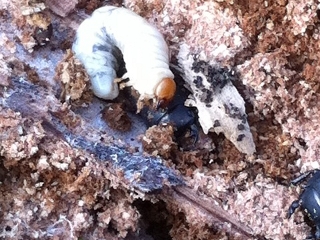
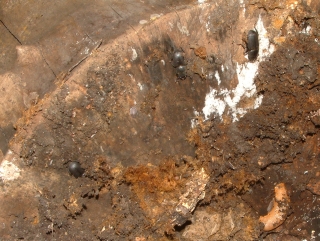
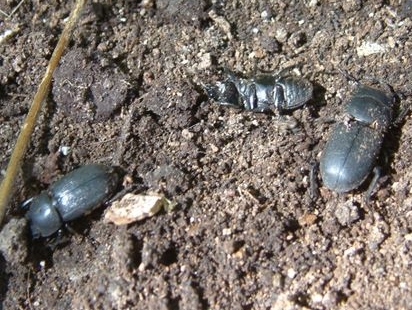
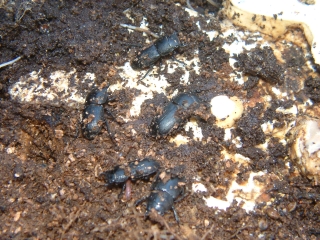
Adult stage:
it is spent most of the time in, or very near, the host wood, white-rotted hardwood.
Adults are often found together with their larvae in tree stumps, logs or even fence posts, some of which might have fungal bodies, particularly Turkeytail (Trametes versicolour)*.
Below are pictures of lesser stag beetles taken throughout the year; the beetles were always ready to take cover because they are very sensitive to disturbances like noises and lights, hence they are not such an easy subject as the stag beetles.

|

|

|

|
| This picture shows a mature larva with a male underneath it, plus an adult escaping on the right. They were found in a plum tree stump in an old orchard. Photo by Donald Oates, Southminster, Essex, March 2011. | Lesser stag beetles discovered under a log. There were more that 3 beetles, the others were very quick at seeking cover inside the wood. Photo by Maria Fremlin, Southfields Park, London, July 2008. | Two males and one female found in a stump, close to the surface. Photo by Maria Fremlin, Limburg, The Netherlands, September 2007. | These lesser stag beetles were found in the winter under a plant pot which had been placed on the top of a stump. There were 4 males and 4 females to start with. These beetles are very flat and can squeeze into rather tight places. Photo by Maria Fremlin, Colchester, Essex, December 2008. |
Breeding season:
they mate probably after they come out of their winter repose. Females lay eggs until quite late in the season and for more than one season as these beetles do not die at the end of the summer like the stag beetles do; I have recaptured several beetles from the previous seasons [1,2].
Probably, they mate inside the host wood, end to end, as some wood inhabiting beetles do [3]. Paul Hendriks who has reared these beetles tells us: “Due to this mating posture, you can see males running after females backwards! It is a very funny sight. The males run as hard backwards as forwards. Sometimes you see them mating in the “normal” position ”. By contrast stag beetles only mate in the “normal position”.
Understandably, pictures of mating lesser stag beetles are extremely scarce; the exception being a very good courtship sequence in Flickr by Claudio Gottardi, taken early May out in the open; click here. This sequence ends in a end to end approach by the male.
In any case, from late spring till the end of the summer they are a bit more active and then there is a chance of finding them after it gets dark. Adults may feed on sap runs and are easily attracted to artificial ones [1,2]. There is evidence from captive reared beetles that the adults may feed on the larvae. As they are attracted to lights, they may even turn up in moth traps [4] and in urban areas they might be accidentally killed by traffic or people.
The pictures below illustrate some situations in which they can be found.
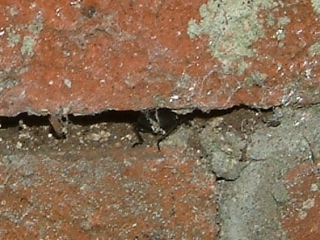
|
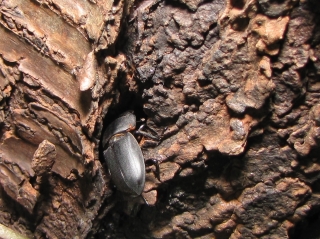
|
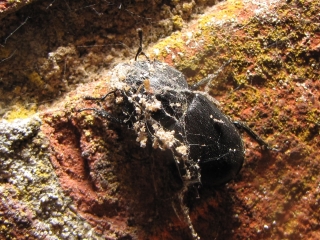
|
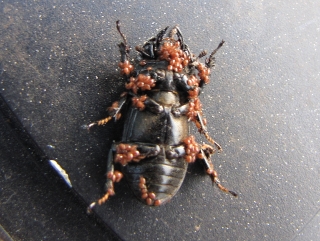
|
| Mystery beetle with his rear end sticking out inside a crack of an old brick wall. It stayed there for over 3 weeks; in the end I had to prise it out in order to find out what it was: a male lesser stag beetle! Photo by Maria Fremlin, Colchester, Essex, 20 June 2005. |
Male lesser stag beetle inside a crack in a stump in the same typical posture. Is this posture likely to attract the females? Photo by Maria Fremlin, Colchester, Essex, 5 July 2010. |
This female had just come out in the evening; she had been hiding in the same brick wall and she got covered with cob webs. By the way, there are a couple of stumps the other side of this brick wall which have lesser stag beetles, see last photo on the row above. Photo by Maria Fremlin, Colchester, Essex, 27 June 2010. |
Female covered with mites; she was recaptured inside a bag of rotting sawdust, six days after the first capture when she already had lots of mites. Photo by Maria Fremlin, Colchester, 23 June 2010. For more about stag beetles and mites, click here. |
Eggs: are laid singly inside rotting wood, usually above the ground away from the soil. Stag beetle females lay their eggs in the soil-wood interface, so they don't clash, click here.
Female lesser stag beetles also take trouble preparing the place where they lay their eggs; with their sharp mandibles they first shred some wood and then lay their eggs close by. It is believed this shredded wood contains special microbes that will help the larva digest it [5,6].
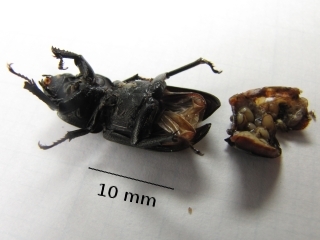
|
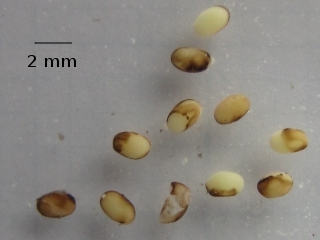
|
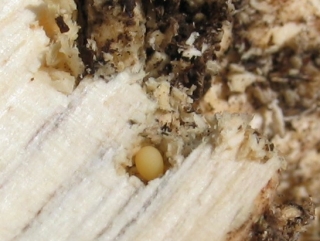
|
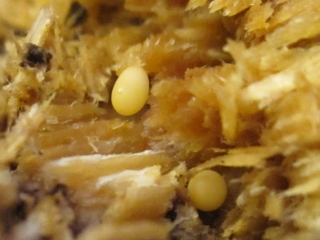
|
| Trodden on female plus dissected abdomen with the eggs on the right. The eggs were not surrounded by fat; compare with the stag beetle eggs here. Photo by Maria Fremlin, Colchester, Essex, 14 July 2010. | 11 eggs found inside the female on the left, slightly oxidized. They were far more than I ever found in trodden stag beetle females and slightly smaller. Photo by Maria Fremlin, Colchester, Essex, 14 July 2010. | A female has dug a pit next to shredded wood and laid an egg in it. When the larva hatches it will feed directly on this wood. Photo taken in captivity by Paul Hendriks, The Netherlands, 15 July 2006. | More eggs laid in captivity; this time they were laid directly on the shredded wood. Photo by Paul Hendriks, The Netherlands, 31 January 2010. |
Larval stage: it is now known that it can be as little as 1 year for eggs laid early in the season; but if the eggs were laid later on, then the larvae will overwinter twice. The larvae undergo 3 instars. The third instar larvae do not get as fat as their bigger cousins do, because they are a much smaller beetle.
Like all stag beetle larvae they stridulate and may, now and again, re-ingest their faecal pellets. Also, as they live quite close together they probably practise cannibalism [7].
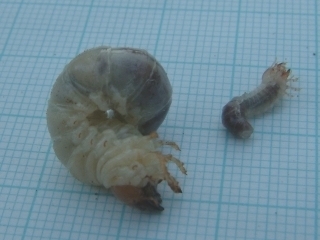
|
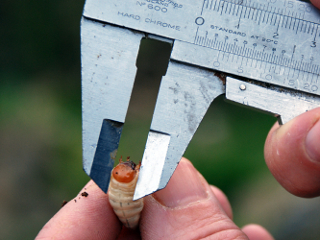
|
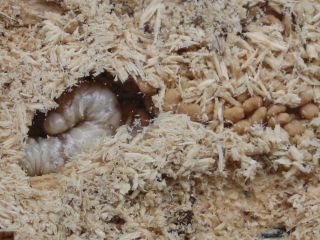
|
|
| A third instar larva next to a much smaller first instar larva, on millimetric paper; smallest division 1mm. Photo by Maria Fremlin, Colchester, 19 June 2007. | The head capsule of a third instar lesser stag beetle larva is about the same size as the stag beetle's second instar, ~ 5 mm, therefore they are not that easy to tell apart. Photo by Tina Bone, Comberton, Cambridgeshire, 2 March 2008. | Third instar larva munching its way through well chipped wood in captivity. The larva is on its back and the head is on the left. Note the trail of faecal pellets left in the tunnel. Photo by Paul Hendriks, The Netherlands, 18 February 2007. | Third instar larva in overwintering mode. That is, in order to prepare itself against the cold, the larva has emptied its gut of all food. It now is full of a liquid that it will protect it from freezing. Photo by Maria Fremlin, Colchester, 4 February 2014. |
Pupation stage: is in the summer inside the wood. The larva prepares an oval pupal chamber in the wood where it has been feeding. It is made of finely shredded compacted wood; very smooth surface. Compare it with the stag beetle's pupation in the soil here
Then it sheds its skin and out comes a pupa.
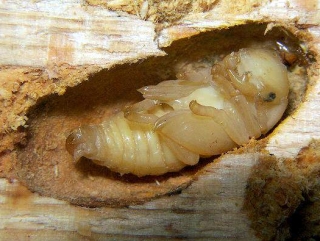
|
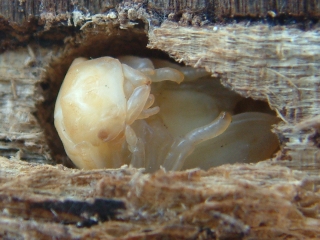
|
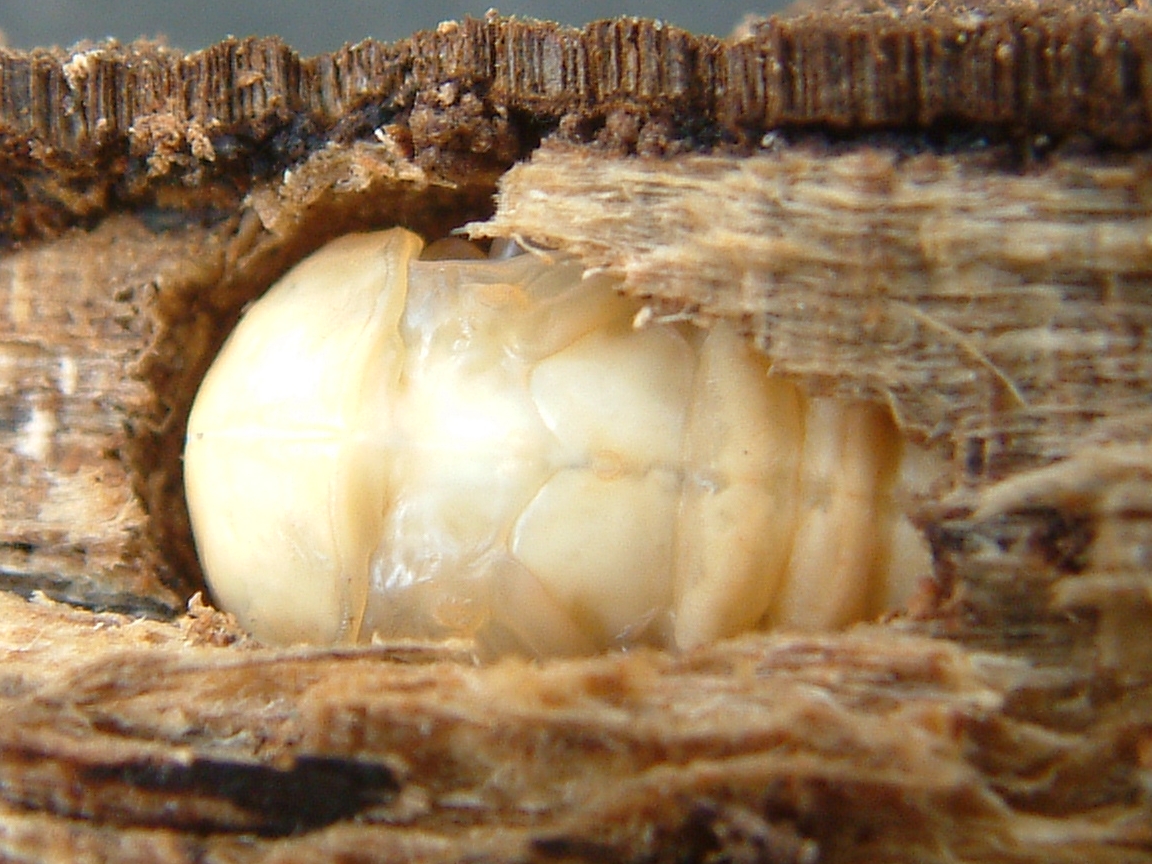
|
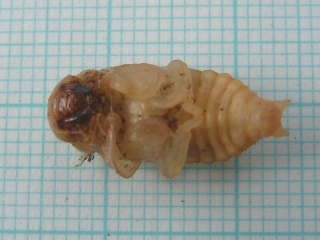
|
| Male lesser stag beetle pupa. Note how the hard wings are folded to the front. Photo by Frank Köhler, Germany, 23 July 2002. | Female lesser stag beetle pupa. Photo by Maria Fremlin, Colchester, Essex, 27 August 2007. | The same pupa but in another position. The pupa rolls around, particularly when disturbed; it is a bit like avoiding bed sores. Photo by Maria Fremlin, Colchester, Essex, 17 August 2007. | A female pupa on the point of eclosion. Note the darker colouration and compare it with a stag beetle pupa. When the adult ecloses its wings will stretch and cover the top of its body. Photo by Maria Fremlin, Colchester, Essex, 17 August 2007. |
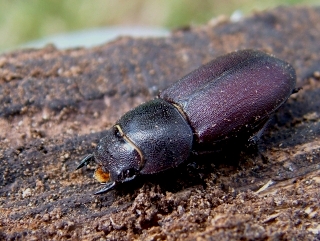
|
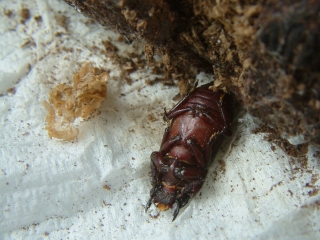
|
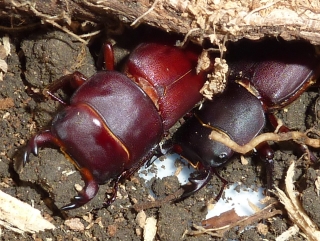
|
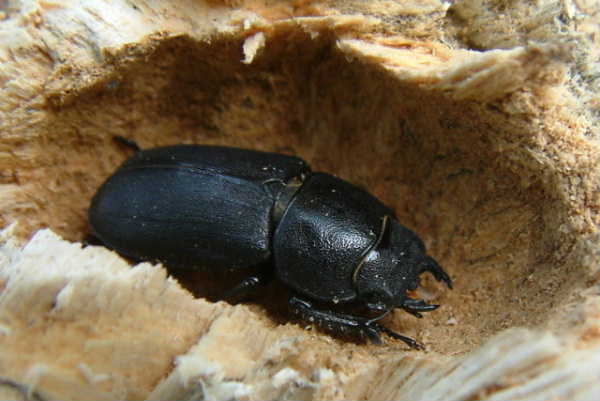
|
| Freshly emerged, teneral, female lesser stag beetle in captivity. She will get darker and darker; for an example of a freshly emerged stag beetle click here. Photo by Maria Fremlin, Colchester, Essex, 22 September 2007. | The same female, underneath view. Note how she has retracted her legs; lesser stag beetles do that, they “play possum” but stag beetles don't. Photo by Maria Fremlin, Colchester, Essex, 22 September 2007. | A couple of teneral males discovered when their stump was disturbed. For more of their photos visit iSpot. Photo by Nikki Tomlin, Hitchen, Hertfordshire, 27 July 2010. | A fully darkened female, 22 mm, discovered inside its pupal case inside an oak branch; she had overwintered there. Photo by Maria Fremlin, Colchester, Essex, May 2002. |
These beetles will mate for the first time during the next season and, if all goes well, they could still be alive the season after next.
* This fungus might even be present in rather old trees and I know of a very old black elder (Acer negundo) which has a good colony of lesser stag beetles around the trunk area where Turkeytail flourishes.
Lesser stag beetles have been observed in living trees in Spain [8] and in the dead wood of living willow trees (Salix spp.) in Japan [9].
References:
[1] Fremlin, M. & Hendriks, P., 2011. Sugaring for stag beetles - different feeding strategies of Lucanus cervus and Dorcus parallelipipedus. The Bulletin of the Amateur Entomologists' Society, 70 (495): 57-67. [PDF]
[2]Fremlin, M. & Hendriks, P., 2013 Lesser Stag Beetles Dorcus parallelipipedus (Coleoptera: Lucanidae) longevity - at least three years. Bulletin of the Amateur Entomologists' Society, 72 (507): 48-56. [PDF]
[3] Schuster, J. C., 1975. A Comparative Study of Copulation in Passalidae (Coleoptera): New Positions for Beetles. The Coleopterists Bulletin, 29 (2), 75-81. For a diagram of their mating positions see page 79 of this pdf.
[4] Gibson, C., 2010. An alternative view from my moth trap: the by-catch. Nature in North-East Essex 2010, 44-54.
[5] Tanahashi M., Matsushita N. and Togashi K., 2009. Are stag beetles fungivorous? J. Insect Physiology (11):983-8.
[6] Tanahashi M., Kubota K., Matsushita N. and Togashi K., 2010. Discovery of mycangia and associated xylose-fermenting yeasts in stag beetles (Coleoptera: Lucanidae). Naturwissenschaften 97: 311-317.
[7] Tanahashi M. and Togashi K., 2009. Interference Competition and Cannibalism by Dorcus rectus (Motschulsky) (Coleoptera: Lucanidae) Larvae in the Laboratory and Field. The Coleopterists Bulletin 63 (3): 301-310.
doi: 10.1649/1143.1
[8] Ángel Martínez García webpage, 2011. http://sites.google.com/site/elcerambyx/home/dorcus-parallelipipedus
[9] Kubota, K. and Nubota, N., 2004. Beetles of genus Dorcus (Coleoptera, Lucanidae) boring into dead wood of willow trees (Salix spp.). Journal of Tree Health, 8 (2): 17-22. [In Japanese]
Acknowledgements:
I am very grateful to all persons who have been so willing to share their photos and observations with a wider public via this webpage.
Last modified: Mon 10 May 2016
| Main | Illustrated stag beetle life cycle | Lesser stag beetle ID guide | Return to the top |